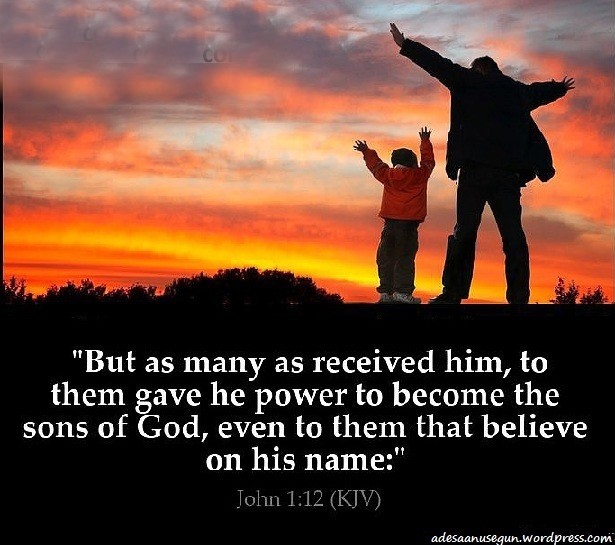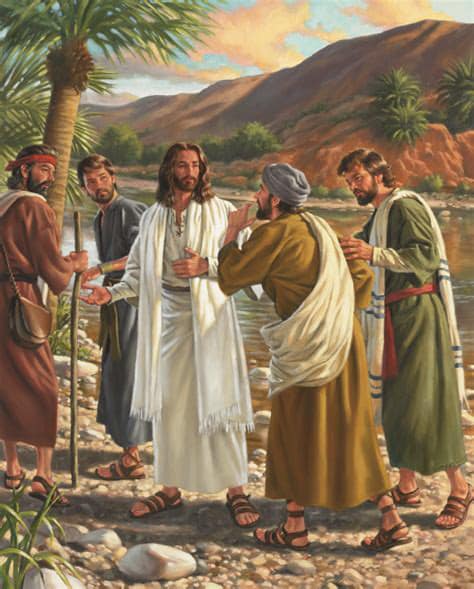To accompany your Come Follow Me study January 16-22
In addition to reading the indicated chapters, you may wish to:
- Read the applicable portions of the New Testament Institute Student Manual at https://www.churchofjesuschrist.org/study/manual/new-testament-student-manual/introduction-to-the-gospel-according-to-st-john/chapter-21-john-1?lang=eng
- Watch the video Come Follow Me (Jan 16-22) – John 1 | Word of Power at (1) Come Follow Me (Jan 16-22) – John 1 | Word of Power – YouTube
- Watch the video The Gospel of John, minutes 0:50-12:50, at https://www.youtube.com/watch?v=kAAZ6HPXdMU
If you would like a Kahoot game related to this material which you could use for personal study or use with your family or your class, click here: https://create.kahoot.it/share/john-1/f7c8a970-fab5-4eff-9486-b193c5f0f8db. (To use it with a group, after clicking on this link, you will need to log into Kahoot, creating a free account if you have not done so previously, then click on the blue “Start” button.)
Points to Ponder in John 1
1. What significant things do we learn about the premortal Jesus Christ from John’s record?
2. Though the term “Light of Christ” does not appear in his Gospel, what does John teach us of significance about that “light”?

3. Aren’t we already all sons and daughters of God? What does it mean, then, that Christ gave “power to become the sons of God, even to them that believe on his name”?

4. How can we respond to someone who argues that Joseph Smith couldn’t have had the vision he claimed to have had, since “No man hath seen God at any time”? (John 1:18.)

5. What do you consider the other most significant contributions of the Joseph Smith Translation to our understanding of John 1?
6. Why does John call Jesus “the Lamb of God”? How is a lamb better than a cow, horse, or chicken?

7. What current use has the Church made of Jesus’ invitation, “Come and see”? (John 1:39)

8. Why did Jesus give Simon the new name of Cephas, meaning a stone? Is that a compliment?
9. Why might we assume Jesus said to Nathanael, “Behold an Israelite indeed, in whom is no guile”? (John 1:47)

Possible Answers to Points to Ponder in John 1
1. What significant things do we learn about the premortal Jesus Christ from John’s record?
- He was in the beginning with God. (1:1-2)
- He was the Creator of “all things.” (1:3)
- He Himself held the “rank” of God. (1:1)
- It was He who enlightened men (provided them with a conscience) and gave power to men to “become the sons of God” even before His birth. (1:4, 9, 12)

2. Though the term “Light of Christ” does not appear in his Gospel, what does John teach us of significance about that “light”?
It is universal, giving light to “every man that cometh into the world.” (1:9) John does not elaborate on the subject, but through other scriptures we learn, as is summarized in the Bible Dictionary:
“The light of Christ is just what the words imply: enlightenment, knowledge, and an uplifting, ennobling, persevering influence that comes upon mankind because of Jesus Christ. For instance, Christ is ‘the true light that lighteth every man that cometh into the world’ (D&C 93:2; see John 1:9). The light of Christ fills the ‘immensity of space’ and is the means by which Christ is able to be ‘in all things, and is through all things, and is round about all things.’ It ‘giveth life to all things’ and is ‘the law by which all things are governed.’ It is also ‘the light that quickeneth’ man’s understanding (see D&C 88:6–13, 41). In this manner, the light of Christ is related to man’s conscience and tells him right from wrong (Moro. 7:12–19).
“The light of Christ should not be confused with the personage of the Holy Ghost, for the light of Christ is not a personage at all. Its influence is preliminary to and preparatory to one’s receiving the Holy Ghost” (Bible Dictionary, “Light of Christ”).
3. Aren’t we already all sons and daughters of God? What does it mean, then, that Christ gave “power to become the sons of God, even to them that believe on his name”?
In one sense, yes, we are all spirit children of God, having been “born” as spirits in the premortal life. But Jesus taught that we all need to be “born again,” in a symbolic and adoptive sense, becoming His sons and daughters, taking upon us His name, and being quickened by His Spirit. Only those so reborn would be entitled to become His heirs in eternity.
4. How can we respond to someone who argues that Joseph Smith couldn’t have had the vision he claimed to have had, since “No man hath seen God at any time”? (John 1:18.)
Obviously, something is wrong with the passage as it stands, as the Bible records that many ancient prophets did indeed see God, including Moses, Aaron, seventy of the elders of Israel, Solomon, Isaiah, Abraham, Amos, and evidently Ezekiel and Enoch. Why would anyone prefer to give more weight to one passage which seems to say no one has ever seen God than to multiple passages which testify to the contrary? Under inspiration, Joseph Smith corrected this passage to read: “And no man hath seen God at any time, except he hath borne record of the Son; for except it is through him no man can be saved.”
5. What do you consider the other most significant contributions of the Joseph Smith Translation to our understanding of John 1?
Your choice. There are a lot of cosmetic and explanatory changes to John 1 in the JST, but most of them do little to clarify or expand upon basic doctrine. However, there are several passages relating to John the Baptist and “Elias” which, depending on one’s point of view, either clarify or further obscure the oft-confusing Latter-day Saint concept of who or what the term “Elias” means. The reader will want to read the entire list of changes in the Joseph Smith Translation Appendix which accompanies the Bible Study Helps in the Gospel Library. Points to note would seem to include:
- Contrary to what it appears from the King James Version, John the Baptist did not deny that he was, in a symbolic sense, “Elias.” He came to prepare the way before Jesus’ first coming much as a latter-day “Elias” would come to prepare the way for His second coming.
- John did deny being either the Elias who was to restore all things or the Christ, who would also bear the title of Elias.
- We might note that In Matthew 17:11-13, after the apostles had seen the transfigured Moses and Elijah (Elias in Greek), they asked Jesus about that prophet’s prophesied future coming. Jesus responded, “Elias truly shall first come, and restore all things. But I say unto you, That Elias is come already, and they knew him not, but have done unto him whatsoever they listed…. Then the disciples understood that he spake unto them of John the Baptist.” There was once a time when well-meaning missionaries used Matthew 17:11-13 to try to prove to investigators that John the Baptist’s latter-day coming to Joseph Smith was prophesied in the scriptures. But John did not and could not “restore all things,” as he held only the Aaronic Priesthood. Jesus did not mean that John the Baptist would restore authority he didn’t even possess, but that John acted as a forerunner to the Savior’s mortal mission, just as another “Elias” would in the latter days.
- It is worth noting that in D&C 27:6-7, we get further discussion of the Elias who would have the “keys of bringing to pass the restoration of all things spoken by the mouth of all the holy prophets since the world began.” We learn that that Elias was the same personage who visited Zacharias and promised he would have a son. That Elias is known in the New Testament as Gabriel, who Joseph Smith said was the same as Noah. Joseph Smith also taught that Noah stood next to Adam in priesthood authority. It may well be Noah, referred to as “Elias” in D&C 110, who visited Joseph Smith and Oliver Cowdery and conferred upon them “the dispensation of the gospel of Abraham.” It appears from Old Testament chronology that Noah would indeed have been the senior priesthood authority on the earth at the time of Abraham and would therefore be an appropriate emissary to send to restore sacred keys in the last days.
- Finally, the term “Elias” can clearly have multiple meanings, especially in Latter-day Saint parlance. It can mean Elijah. It symbolically can mean John the Baptist, Christ, and Gabriel, or Noah. There may or may not have ever been anyone of importance, separate from Elijah, who actually bore that name, though many have born the title which derived from that name. Just as Malachi foretold Elijah’s latter-day coming to prepare the way for the Lord’s return, so have others who have had a preparatory mission been said to be acting in the “spirit of Elias.” It may well be that if Joseph Smith were still around, he could further clarify some of what he taught on the subject.
6. Why does John call Jesus “the Lamb of God”? How is a lamb better than a cow, horse, or chicken?
Presumably because a lamb is the very epitome of meekness. And because Isaiah had foretold that the Messiah would be “brought as a lamb to the slaughter.” (Isa. 53:7.) Though the Creator of heaven and earth, Jesus obediently and cheerfully submitted to His Father’s will, suffered unfathomable agony for the sins and imperfections of us all, and accepted an excruciating death.
7. What current use has the Church made of Jesus’ invitation, “Come and see”? (John 1:39)
See the great video and commentary at https://www.youtube.com/watch?v=FhMshDkJnsk
8. Why did Jesus give Simon the new name of Cephas, meaning a stone? Is that a compliment?
Surely it was intended by Jesus to be a compliment and to raise Simon’s understanding of what he was called to be. Most have assumed that Jesus had reference to the strength of a big stone, upon which a building might be erected. But the JST gives a further insight: “Thou shalt be called Cephas, which is, by interpretation, a seer, or a stone.” In other words, Peter was to be not so much the building block kind of stone as the kind of “seer stone” Joseph Smith used to translate the Book of Mormon. He would become the chief prophet, seer, and revelator after Christ’s departure.

9. Why might we assume Jesus said to Nathanael, “Behold an Israelite indeed, in whom is no guile”? (John 1:47)
One possibility is that just as Jesus knew Nathanael had been sitting under a fig tree, he also knew through revelation that Nathanael had asked Philip, “Can any good thing come out of Nazareth”? Jesus might in essence be saying, “Nathanael, you aren’t full of the pretense that most people are. You speak your mind, without concern for what anyone else thinks of what you say. That is refreshing!”
Most likely, however, the full answer is deeper than that. Fig trees were common places of prayer and meditation. Jesus may well have seen into Nathanael’s soul and recognized that he was truly pure in heart, without any semblance of deceit or fraud, as the footnote 47b tells us “guile” means in the original Greek.
